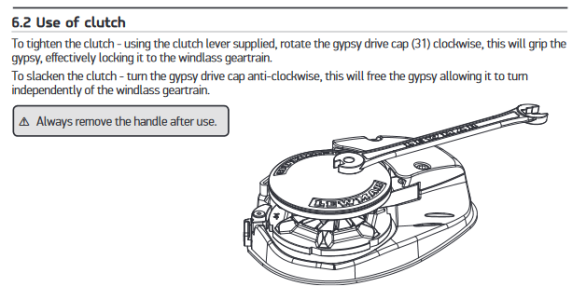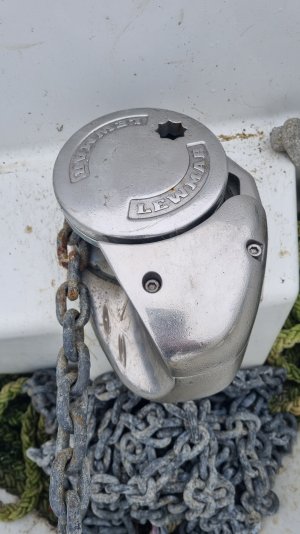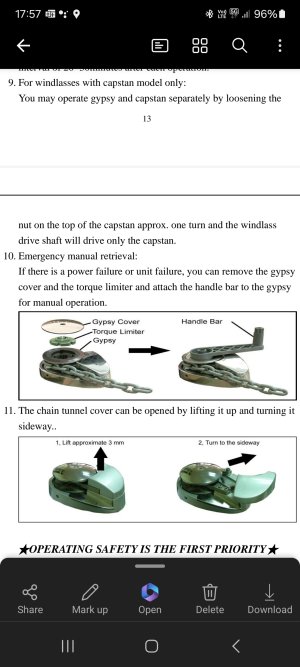You are using an out of date browser. It may not display this or other websites correctly.
You should upgrade or use an alternative browser.
You should upgrade or use an alternative browser.
How to get anchor up if electric windlass fails
- Thread starter Adetheheat
- Start date
Stemar
Well-known member
Plan A - pull it up by hand. When that gets too hard,
Plan B - attach a messenger line to the rode and lead it to a winch. You'd only be able to get a metre or so up at a time, but you probably only need this to break it out of the bottom.
Plan B - attach a messenger line to the rode and lead it to a winch. You'd only be able to get a metre or so up at a time, but you probably only need this to break it out of the bottom.
Boathook
Well-known member
Plan C is to let iit all out and attach a fender or fenders to the end and retrieve once the fault has been fixed.
PCUK
Well-known member
I'm sure there is some mechanical back-up in this situation. Look on the Lewmar website for details of how to do it with your windlass.
andsarkit
Well-known member
thinwater
Well-known member
RTFM! Rude, but funny.
But I agree with Stemar. Also a good reason to have a chain lock/pawl. Makes it MUCH easier, because you can take breaks between hauls.
If it is windy, Boathook is right. This is why you have another anchor and rode.
But I agree with Stemar. Also a good reason to have a chain lock/pawl. Makes it MUCH easier, because you can take breaks between hauls.
If it is windy, Boathook is right. This is why you have another anchor and rode.
Sea Change
Well-known member
All good answers.
I only upgraded to an electric windlass a few months ago. I still pull up by hand if we're in less than about 20ft depth, just force of habit I suppose.
I only upgraded to an electric windlass a few months ago. I still pull up by hand if we're in less than about 20ft depth, just force of habit I suppose.
salar
Active member
If you have enough power you can jury rig an alderney ring with a couple of fenders and a loop of rope. See how it's done here (scroll down for diagrams and video) Boat Handling - Boat Angling
johnalison
Well-known member
My Lofrans windlass has a central hole for the handle but the instructions are as per #5, just keep winding. There is a lot of friction and it is very slow but can be done. Even with my 45lb anchor it wou”d probably be easier just to haul it up by hand and then feed it into the chain locker round the windlass.
Adetheheat
Member
What is the gypsy drive cap? The star shape socket seems to be for tightening it.Page 9 of the manual.
View attachment 172514
LittleSister
Well-known member
Whether haul the chain by hand, or winding the windlass manually, avoid trying to imitate the speed and continuous winding of an electric (or hydraulic) windlass. That takes far too much pain and effort that can be avoided. Use your brains to take some of the load off your body.
Getting the anchor detached from the bottom is the hardest part when doing it manually (by the above methods or whatever). Don't knacker yourself doing that bit manually if you can avoid it. So, haul or wind in the chain until it's vertical or nearly so and it gets hard, then cleat it off. The boat moving around and especially up/down in waves, swell, wind, current or tide will usually soon break the anchor out of the bottom. (You might need to take in any slack that arises, especially in mud, then allow this 'automatic' process to continue.) You'll notice when it becomes free as the boat will typically start facing a different direction and then start noticeably moving away from the anchored position.
Beforehand, for getting to that 'vertical chain' stage, either use the motor to get the boat over the anchor, or take it slow to avoid un-needed effort. Haul in the anchor a little so the chain comes up straighter, then wait a few moments. The weight of the chain will pull the boat towards the anchor (unless its blowing a full gale.) Haul in the chain a bit more, wait again, etc. Don't try to go too fast. Very much less work than trying to do it faster and continuous.
After breaking out of the bottom, also take it steady getting the length of chain up if the situation allows. You can motor or sail along at modest speed with the anchor and chain still down once you've got it clear of whatever depths you have around, taking in the chain slowly, perhaps a little at a time, to avoid burning your muscles/joints or getting yourself winded.
While hauling, console yourself that people pay good money to do this kind of thing at a gym!
Getting the anchor detached from the bottom is the hardest part when doing it manually (by the above methods or whatever). Don't knacker yourself doing that bit manually if you can avoid it. So, haul or wind in the chain until it's vertical or nearly so and it gets hard, then cleat it off. The boat moving around and especially up/down in waves, swell, wind, current or tide will usually soon break the anchor out of the bottom. (You might need to take in any slack that arises, especially in mud, then allow this 'automatic' process to continue.) You'll notice when it becomes free as the boat will typically start facing a different direction and then start noticeably moving away from the anchored position.
Beforehand, for getting to that 'vertical chain' stage, either use the motor to get the boat over the anchor, or take it slow to avoid un-needed effort. Haul in the anchor a little so the chain comes up straighter, then wait a few moments. The weight of the chain will pull the boat towards the anchor (unless its blowing a full gale.) Haul in the chain a bit more, wait again, etc. Don't try to go too fast. Very much less work than trying to do it faster and continuous.
After breaking out of the bottom, also take it steady getting the length of chain up if the situation allows. You can motor or sail along at modest speed with the anchor and chain still down once you've got it clear of whatever depths you have around, taking in the chain slowly, perhaps a little at a time, to avoid burning your muscles/joints or getting yourself winded.
While hauling, console yourself that people pay good money to do this kind of thing at a gym!
Last edited:
Roberto
Well-known member
A chain hook, better two, attached to a line to a mast or cockpit winch allows several metres to be recovered at a time, plus a final hook with short strop to quickly lock eerything in place. I find my genoa sheet winches have too high a speed ratio, meaning it gets very slow, the mast winches are quicker and the effort remains reasonable.
With the slightest wind/current, I'd be very wary of repeatedly handling chain with my hands (and I always wear gloves), pulling locking etc etc taut chain while being a few cm away from fixed pieces of metal like gypsy, windlass, cleats and so on; especially towards the end when one is tired, errors or distractions can be costly with pieces of body meat or bones.
With the slightest wind/current, I'd be very wary of repeatedly handling chain with my hands (and I always wear gloves), pulling locking etc etc taut chain while being a few cm away from fixed pieces of metal like gypsy, windlass, cleats and so on; especially towards the end when one is tired, errors or distractions can be costly with pieces of body meat or bones.
capnsensible
Well-known member
This gives you the opportunity to bargain with the fisherman who already took it assuming you can actually find them and speak their language....Plan C is to let iit all out and attach a fender or fenders to the end and retrieve once the fault has been fixed.
Stemar
Well-known member
A couple of times, the only way I could retrieve my anchor was to motor it out. Ideally, a weaker crew member is on the helm, and the strongest up forward. Motor towards the anchor while the deck crew pulls in the slack. As you get to the anchor, take a turn round a cleat or Samson post. As the rode goes tight, the anchor will (in theory) pull free of the bottom and allow you to retrieve it. After sitting out a blow in Poole Harbour, it took three tries to get it up.
Your windlass looks like mine, though mine's a Quick. I though I could wind the anchor up by hand, but it turned out that the hole for the winch handle is to adjust the clutch.
Your windlass looks like mine, though mine's a Quick. I though I could wind the anchor up by hand, but it turned out that the hole for the winch handle is to adjust the clutch.
Andrew_Trayfoot
Active member
andsarkit
Well-known member
Found a better version of the manual.What is the gypsy drive cap? The star shape socket seems to be for tightening it.

When the clutch is tightened the cap is locked to the gypsy and further clockwise rotation will rotate both and wind in the chain. It looks like a winch handle would fit and be more comfortable to use although it would still be very awkward to crouch down and operate. You will be turning the motor as well so it will be very inefficient.
As said above if you slowly take in the slack chain by hand as you motor to vertically above the anchor you are only lifting a few metres of chain at a time. Let the motion of the boat break out the anchor and then use the winch to raise the anchor if it is too heavy to pull up by hand.
I don't have an anchor winch and am too old to use brute force so doing it like this is the only possible way for me. (9kg anchor and 6mm chain so quite easy)
Neeves
Well-known member
Most windlass take a winch handle to loosen the clutch and retrieve the chain. However to use the winch handle to retrieve the chain means you need swing room, the radius dictated by the length of the winch handle. Sometimes there is a deck fitting in the way and the theory is good - but you do not have sufficient room.
Maxwell supply, at a cost, an extender allowing you to lift the winch handle well above the windlass. Maxwell also supply a winch handle. You will find their winch handle is slightly modified to take a lock bolt where the winch handle fits - their winch handle fits but ostensibly identical 'normal' winch handles do not fit.
By far the easiest way to retrieve is by hand and be grateful you installed 6mm not 8mm chain. Just pull it in hand over hand, leave it on the deck to be sorted out later.
As mention a series of chain hooks on short strops allow you to take a break. Gloves are an essential bit of kit.
Windlass are very robust and survive with little or no servicing - but unless you enjoy the physical effort it is strongly advised to service the windlass annually (its easy). Common failures are the shaft locking/siezing (clean and re-grease) or no oil in the gear box. If you do not torque the cable connections sufficiently they can loosen (there is much vibration) - so if the windlass, apparently dies, check the cable connections first. Windlass are housed in an awful environment - lots of salt water. You will extend the life of the windlass if you instal baffles to keep the worst of the salt water off the motor (and even better paint the motor with the paint they use to seal the underside of cars from salt in the winter). Most windlass last 'for ever', given they abuse they receive, and are a credit to the manufacturers.
Jonathan
Maxwell supply, at a cost, an extender allowing you to lift the winch handle well above the windlass. Maxwell also supply a winch handle. You will find their winch handle is slightly modified to take a lock bolt where the winch handle fits - their winch handle fits but ostensibly identical 'normal' winch handles do not fit.
By far the easiest way to retrieve is by hand and be grateful you installed 6mm not 8mm chain. Just pull it in hand over hand, leave it on the deck to be sorted out later.
As mention a series of chain hooks on short strops allow you to take a break. Gloves are an essential bit of kit.
Windlass are very robust and survive with little or no servicing - but unless you enjoy the physical effort it is strongly advised to service the windlass annually (its easy). Common failures are the shaft locking/siezing (clean and re-grease) or no oil in the gear box. If you do not torque the cable connections sufficiently they can loosen (there is much vibration) - so if the windlass, apparently dies, check the cable connections first. Windlass are housed in an awful environment - lots of salt water. You will extend the life of the windlass if you instal baffles to keep the worst of the salt water off the motor (and even better paint the motor with the paint they use to seal the underside of cars from salt in the winter). Most windlass last 'for ever', given they abuse they receive, and are a credit to the manufacturers.
Jonathan
Slowtack
Well-known member
An anchor buoy attached to the crown helps in breaking out if the anchor is well embedded... .. Bringing the buoy line... Or extending it... To a winch aboard if necessary...
VicS
Well-known member
Which goes on to sayFound a better version of the manual.
View attachment 172520
When the clutch is tightened the cap is locked to the gypsy and further clockwise rotation will rotate both and wind in the chain. It looks like a winch handle would fit and be more comfortable to use although it would still be very awkward to crouch down and operate. You will be turning the motor as well so it will be very inefficient.
As said above if you slowly take in the slack chain by hand as you motor to vertically above the anchor you are only lifting a few metres of chain at a time. Let the motion of the boat break out the anchor and then use the winch to raise the anchor if it is too heavy to pull up by hand.
I don't have an anchor winch and am too old to use brute force so doing it like this is the only possible way for me. (9kg anchor and 6mm chain so quite easy)

However ITYWF the OP has a modest sized power boat so hauling in by hand should not be a difficult task ............. but there are not likely to other winches that can be used as suggested in some posts in this thread.
.
Tranona
Well-known member
I had the same windlass on my last boat and the motor seized so impossible to move it at all. As suggested locking it and using the handle works very slowly if the motor is free. I retrieved the anchor manually.If the electric windlass fails how do i get the anchor up? The star shaped socket in photo attached is used for when it slips and needs tightening. However what do I do when it totally fails due to say no power?



